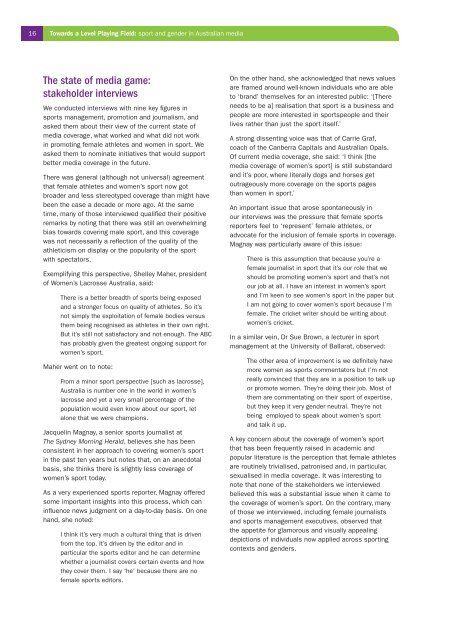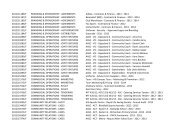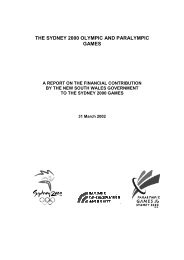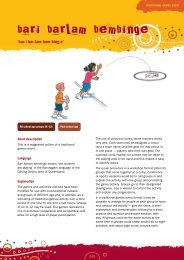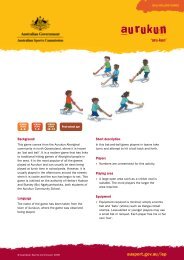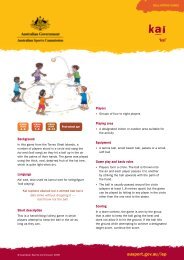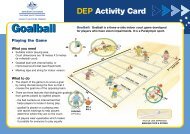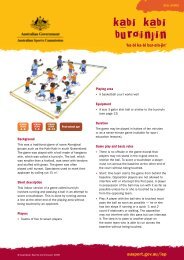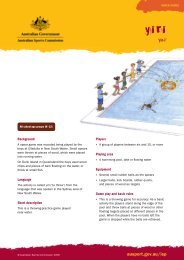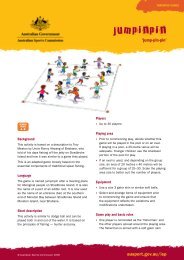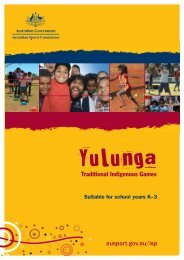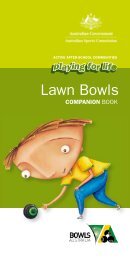Towards a Level Playing Field - Australian Sports Commission
Towards a Level Playing Field - Australian Sports Commission
Towards a Level Playing Field - Australian Sports Commission
Create successful ePaper yourself
Turn your PDF publications into a flip-book with our unique Google optimized e-Paper software.
16<br />
<strong>Towards</strong> a <strong>Level</strong> <strong>Playing</strong> <strong>Field</strong>: sport and gender in <strong>Australian</strong> media<br />
The state of media game:<br />
stakeholder interviews<br />
We conducted interviews with nine key fi gures in<br />
sports management, promotion and journalism, and<br />
asked them about their view of the current state of<br />
media coverage, what worked and what did not work<br />
in promoting female athletes and women in sport. We<br />
asked them to nominate initiatives that would support<br />
better media coverage in the future.<br />
There was general (although not universal) agreement<br />
that female athletes and women’s sport now got<br />
broader and less stereotyped coverage than might have<br />
been the case a decade or more ago. At the same<br />
time, many of those interviewed qualifi ed their positive<br />
remarks by noting that there was still an overwhelming<br />
bias towards covering male sport, and this coverage<br />
was not necessarily a refl ection of the quality of the<br />
athleticism on display or the popularity of the sport<br />
with spectators.<br />
Exemplifying this perspective, Shelley Maher, president<br />
of Women’s Lacrosse Australia, said:<br />
There is a better breadth of sports being exposed<br />
and a stronger focus on quality of athletes. So it’s<br />
not simply the exploitation of female bodies versus<br />
them being recognised as athletes in their own right.<br />
But it’s still not satisfactory and not enough. The ABC<br />
has probably given the greatest ongoing support for<br />
women’s sport.<br />
Maher went on to note:<br />
From a minor sport perspective [such as lacrosse],<br />
Australia is number one in the world in women’s<br />
lacrosse and yet a very small percentage of the<br />
population would even know about our sport, let<br />
alone that we were champions.<br />
Jacquelin Magnay, a senior sports journalist at<br />
The Sydney Morning Herald, believes she has been<br />
consistent in her approach to covering women’s sport<br />
in the past ten years but notes that, on an anecdotal<br />
basis, she thinks there is slightly less coverage of<br />
women’s sport today.<br />
As a very experienced sports reporter, Magnay offered<br />
some important insights into this process, which can<br />
infl uence news judgment on a day-to-day basis. On one<br />
hand, she noted:<br />
I think it’s very much a cultural thing that is driven<br />
from the top. It’s driven by the editor and in<br />
particular the sports editor and he can determine<br />
whether a journalist covers certain events and how<br />
they cover them. I say ‘he’ because there are no<br />
female sports editors.<br />
On the other hand, she acknowledged that news values<br />
are framed around well-known individuals who are able<br />
to ‘brand’ themselves for an interested public: ‘[There<br />
needs to be a] realisation that sport is a business and<br />
people are more interested in sportspeople and their<br />
lives rather than just the sport itself.’<br />
A strong dissenting voice was that of Carrie Graf,<br />
coach of the Canberra Capitals and <strong>Australian</strong> Opals.<br />
Of current media coverage, she said: ‘I think [the<br />
media coverage of women’s sport] is still substandard<br />
and it’s poor, where literally dogs and horses get<br />
outrageously more coverage on the sports pages<br />
than women in sport.’<br />
An important issue that arose spontaneously in<br />
our interviews was the pressure that female sports<br />
reporters feel to ‘represent’ female athletes, or<br />
advocate for the inclusion of female sports in coverage.<br />
Magnay was particularly aware of this issue:<br />
There is this assumption that because you’re a<br />
female journalist in sport that it’s our role that we<br />
should be promoting women’s sport and that’s not<br />
our job at all. I have an interest in women’s sport<br />
and I’m keen to see women’s sport in the paper but<br />
I am not going to cover women’s sport because I’m<br />
female. The cricket writer should be writing about<br />
women’s cricket.<br />
In a similar vein, Dr Sue Brown, a lecturer in sport<br />
management at the University of Ballarat, observed:<br />
The other area of improvement is we defi nitely have<br />
more women as sports commentators but I’m not<br />
really convinced that they are in a position to talk up<br />
or promote women. They’re doing their job. Most of<br />
them are commentating on their sport of expertise,<br />
but they keep it very gender neutral. They’re not<br />
being employed to speak about women’s sport<br />
and talk it up.<br />
A key concern about the coverage of women’s sport<br />
that has been frequently raised in academic and<br />
popular literature is the perception that female athletes<br />
are routinely trivialised, patronised and, in particular,<br />
sexualised in media coverage. It was interesting to<br />
note that none of the stakeholders we interviewed<br />
believed this was a substantial issue when it came to<br />
the coverage of women’s sport. On the contrary, many<br />
of those we interviewed, including female journalists<br />
and sports management executives, observed that<br />
the appetite for glamorous and visually appealing<br />
depictions of individuals now applied across sporting<br />
contexts and genders.


